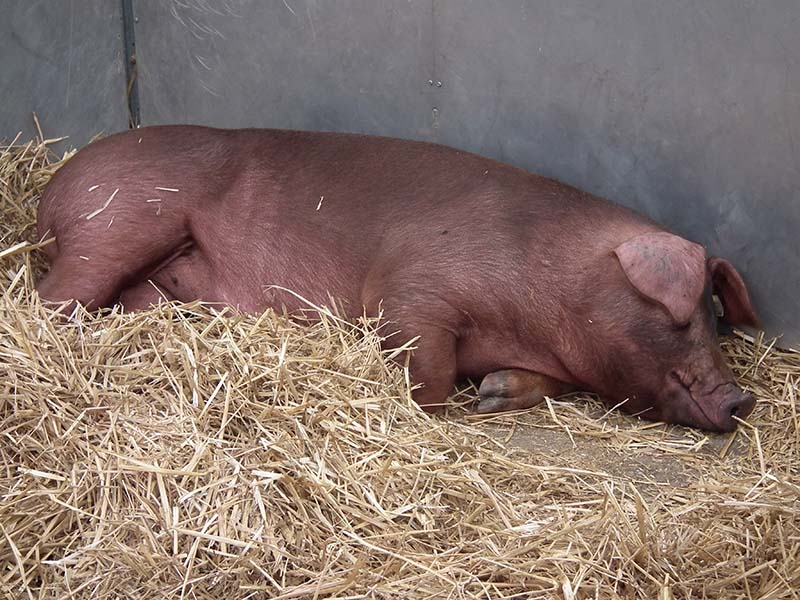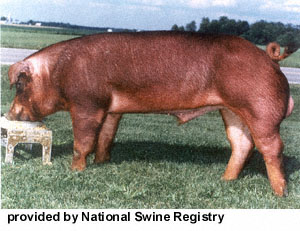Duroc Swine
The Duroc breed of hogs had its origin in the eastern United States and in the Corn Belt. It would seem presumptuous today to attempt to identify the foundation stock of the breed, which was originally called the Duroc-Jersey, because persons attempting to write the history of the breed only a few years after it was formed could not definitely state the exact source of the red hogs that went into their foundation. one source of the red or reddish-brown hogs that were found in the United States was reputed to be those that came from the Guinea coast of Africa, and it is said that hogs similar to those found on the Guinea coast were found in every country to which early slave trading vessels found their way. In The Story of Durocs it is stated that red hogs were brought to America by Columbus on his second voyage, and red hogs were also brought to this country by DeSoto. These were presumed to have come from Spain and Portugal, and red hogs were sent from Portugal to Nova Scotia. In The Breeds of Livestock, Sanders is of the opinion that reddish-brown hogs of the Berkshire strain were brought to the United States and probably found their way into the Duroc breed.
 In 1837 Henry Clay imported four red shoats from Spain for his farm at Ashland, Kentucky.
Daniel Webster imported similar hogs from Spain or Portugal in 1852 for his farm in
Massachusetts, but Mr. Webster died soon afterward, and the hogs passed to the ownership
of his relative and were scattered into several states. The exact distribution of
these importations and other that were probably made is not known, so it cannot be
accurately stated just what part any of these hogs may have played in the formation
of the Duroc breed.
In 1837 Henry Clay imported four red shoats from Spain for his farm at Ashland, Kentucky.
Daniel Webster imported similar hogs from Spain or Portugal in 1852 for his farm in
Massachusetts, but Mr. Webster died soon afterward, and the hogs passed to the ownership
of his relative and were scattered into several states. The exact distribution of
these importations and other that were probably made is not known, so it cannot be
accurately stated just what part any of these hogs may have played in the formation
of the Duroc breed.
The Origin of Duroc-Jersey
Two distinct strains of hogs, the Jersey Red of New Jersey and the Duroc of New York, entered into the building of the Duroc-Jersey breed. Little of the actual crossing of the two strains of hogs was done in the two states in which they originated, but much of the amalgamation of the two strains into one breed took place in the Midwestern states.
The Jersey Reds
The strain of hogs that later became known as the Jersey Reds was well established in New Jersey prior to 1850. Clerk Pettit, a very noted early breeder of red hogs in that state, suggested that the red hogs found in New Jersey came from an importation to the state in 1820, but others have suggested that the strain was found there at even an earlier date. These hogs were referred to as "red hogs" for many years and gained an enviable reputation because of their extreme size, rugged constitutions and prolificacy. They were a variety of hogs that lacked in quality, being very coarse in the hair coat and bone and were long and rangy. The hogs reached an enormous size at maturity, gained an enviable reputation for the very heavy weight that they attained and were favorably accepted at the near-by markets. The name Jersey Reds was first attached to the hogs in the New Jersey area by Joseph B. Lyman, Agricultural Editor of the New York Tribune, who resided in New Jersey. Shortly after he coined the name, a Mr. Lippincott used the name in advertising his hogs, and from that time on the name of Jersey Red stayed with the red hogs of that area.
The Duroc Strain
 The Duroc strain of hogs was started in Saratoga County, New York, by Isaac Frink
who lived near Milton. he secured his first hogs in 1823 from Harry Kelsey, who had
moved to Florida, Montgomery County, New York, in 1822. Mr. Kelsey was standing the
famous Thoroughbred stallion Duroc, and Mr. Frink visited the Kelsey farm to see the
horse. While at the Kelsey homestead he spied some red pigs that very much took his
fancy, and he purchased some of them and took them home. Since the pigs had no breed
name, he called them Durocs in honor of the stallion. Mr. Kelsey was said to have
told Mr. Frink that the hogs had been imported, but just how many generations had
elapsed since the importation, or whence the hogs had come, was never established.
The Duroc hogs were of smaller size and more compact, but had greater quality and
aptitude to take on fleshing at an early age than did the Jersey Reds.
The Duroc strain of hogs was started in Saratoga County, New York, by Isaac Frink
who lived near Milton. he secured his first hogs in 1823 from Harry Kelsey, who had
moved to Florida, Montgomery County, New York, in 1822. Mr. Kelsey was standing the
famous Thoroughbred stallion Duroc, and Mr. Frink visited the Kelsey farm to see the
horse. While at the Kelsey homestead he spied some red pigs that very much took his
fancy, and he purchased some of them and took them home. Since the pigs had no breed
name, he called them Durocs in honor of the stallion. Mr. Kelsey was said to have
told Mr. Frink that the hogs had been imported, but just how many generations had
elapsed since the importation, or whence the hogs had come, was never established.
The Duroc hogs were of smaller size and more compact, but had greater quality and
aptitude to take on fleshing at an early age than did the Jersey Reds.
About 1830, William Ensign of Stillwater, Saratoga County, New York, secured a pair of red pigs in Connecticut that crossed very well with the strain that Mr. Frink had developed. Most of the red hogs in Connecticut at that time were said to have been of the Red Berkshire strain that had come to Long Island around 1820. The Duroc breeders were progressive, and in 1877 breeders from Saratoga and Washington counties, New York, met and decided on a scale of points for their breed of swine. While the Durocs of that day are said to have been smaller than the Jersey Reds, they were extremely heavy compared to what we think of as modern market hogs.
In 1882 two different breeders imported Tamworths into the United States to cross on the strains of red hogs of the time. These two importations were made by Thomas Bennett, of Rossville, Illinois and William H. Holmes and Sons of Grinnell, Iowa. Mr. Bennett brought in seven heads of hog and used them to a very limited extent but was dissatisfied with the offspring and discarded them all. Holmes and Sons imported two head but were not satisfied with their importation and sacrificed them upon arrival. Consequently there is no record that Tamworth blood played any part in the formation of the Duroc breed.
Breed Characteristics
Durocs have considerable variation in color. An acceptable color may range from a very light golden, almost yellow color, to a very dark red that approaches mahogany. The red is a very practical color that suits pork producers, and since it is a solid color there is not concern about fancy points of proper markings. Durocs have a medium length and slight dish of the face. The ears should be drooping and should not be held erect.
Registries and Breed Associations
National Swine Registry
P.O. Box 2417
West Lafayette, IN 47906-2417
Phone: (765) 463-3594
References
Briggs, Hilton M. 1969. Modern Breeds of Livestock. Third Edition, MacMillan Company
